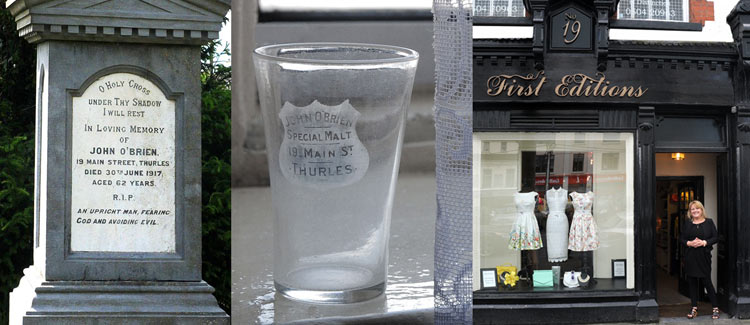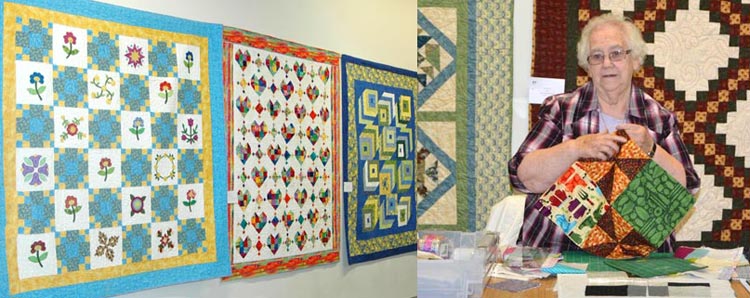|
|
World Missions Ireland – We can bring hope and love to communities where there is turmoil, poverty, and uncertainty.
 Jane Boland with her winning design. Picture: World Missions Ireland. A fifth class student attending Carrig National School, Ballycommon, Nenagh, Co. Tipperary, has beaten more than 4,500 other pupils from around Ireland, to win the right to design the vestments to be worn, here in Ireland, during the visit by the 266th Jesuit Pope Francis (Jorge Mario Bergoglio).
Miss Jane Boland, a truly talented Tipperary schoolgirl and aged just 11 years, designed the vestment for His Holiness Pope Francis based around an image of a globe of the world, and incorporating the cultures and passions of many other nations, while depicting creativity, community, nature and technology; thus reflecting our ever changing world planet.
World Missions Ireland, which is the official charity of Pope Francis for overseas missions, confirmed it was particularly difficult to pick a final winner in this nationwide competition, due to the particularly high standard of the designs submitted.
Miss Boland’s winning entry will now be sent to tailors in Rome, latter who will then be commissioned to recreate it into a life-sized garment. Once completed, World Missions Ireland will then gift these vestments to his Holiness, who will wear them when he attends here in Ireland for the World Meeting of Families next August.
World Missions Ireland will also display a replica of the winning vestment at stands No.23 and No.24, during the World Meeting of Families, to be held in the grounds of the Royal Dublin Society (RDS), scheduled to take place on August 22nd through to August 24th, 2018 next.
Congratulations to Ms Benita Wrochna (Model & Designer), Ms Katelyn Egan (Co-Designer), and Ms Kayleigh Fogarty (Co-Designer), all fourth year students at the Ursuline Convent Secondary School here in Thurles.
Their collaboration behind the ‘haute couture’ creation ‘Palette Prisoner’ has now been chosen as one of just 80 remaining out of some 1500 original creations nationwide.
The three students will now compete for the National Final of Junk Kouture in the 3Arena at North Wall Quay in Dublin, on April 19th next, sponsored by Bank Of Ireland.
How our readers can help.
Online voting will begins on Monday April 1st until Friday April 5th, so naturally our Thurles students are seeking your support in this final stage. Voting can be undertaken by clicking on https://app.junkkouture.com.
With Christmas Day a mere 15 sleeps away, Thurles is beginning to look a lot like Christmas.
All shop windows here in the centre of of the town are now displaying their festive finery, with Hummingbird’s window display (situated in Friar Street, Thurles) particularly imaginative, forcing even the busiest shopper to halt awhile and stare.
Thurles Town Council have long completed the finishing touches to the Christmas street lighting which each year, over this festive season, creates a warm and cheery atmosphere for shoppers.
Yes, Thurles is certainly beginning to look a lot like Christmas and we will be featuring other shop window displays later in the week.
His headstone in St Mary’s Graveyard Thurles, reads: “O holy cross under thy shadow I will rest.” In loving memory of John O’Brien, 19 Main St, Thurles [Co.Tipperary]. Died 30th June 1917, aged 62 years. R I P. “An upright man fearing God and avoiding evil”. [Grave Ref: 349].
 Pic (1) Gravestone of J. O’Brien, No 19, Main St. (Liberty Square) Thurles. Pic (2) A 100-year-old Whisky Glass with the O’Brien name from No 19, Liberty Square (Main St.) Thurles. Pic (3) First Editions today (June 2017) also situated at No 19, Liberty Square (Main St.) Thurles. For the many years that I have been a resident of this town, ‘First Editions’ situated at No 19 Liberty Square, Thurles, (Previously Main Street) has been retailing not just the ‘crème de la crème’ in lady’s fashion and design, but also providing effective fashion guidance; advising ladies of all ages in “what to wear, what to bare, and what to keep under wraps”.
However, No 19 Main Street, Thurles, was not always the home of ‘Haute Couture’ for devoted followers of high fashion. Previously it had been a Licensed Hostelry (Pub, Watering Hole supplying ‘Special Malt’ whiskey) and occupied by Mr John O’Brien. Prior to Mr O’Brien’s tenancy it was occupied by one Mr Adam Cooke, who according to research, possibly ran a Delph and Hardware business before 1843.
Today, following his death almost 100 years ago this month, when we examine his place of burial, we can fairly assume that Mr John O’Brien, was a man of some substance. Born just after the Great Famine and passing away shortly before Thurles became fully involved in the fight for Irish freedom, his headstone epitaph is possibly the only headstone in St Mary graveyard with hammered smooth, lead lettering.
So why letters made using Lead (Symbol Pb, Atomic No 82) ?
Lead lettering on signs and headstones was up to 50 years ago a technique that had been in use for at least the previous three to four hundred years. In our dimmer past, the highlighting of lettering on any type of sign was difficult, due to the absence of long lasting exterior paints, with latter being unfit to endure Irish weathering and thus unable to remain clearly visible to the eye for any great period of time. Lead lettering, therefore, while highly skilled and labour intensive, was the only other option, depending on ones available finances.
Seldom seen today, except in graveyards; this lead lettering would be sketched out on the surface of the stone initially in pencil. The intended inscription would then be incised or scored into the stone using a hammer and different sized sharp chisels, producing a V style cut into the surface. Except for the surface outlines, the stone cutter was not required to finish the carved-out letter shapes cleanly.
Now using a hand driven band drill and a steel bit, the stone mason could drill a series of tiny holes internally into each incised letter. Soft malleable type lead, supplied in sheets and twisted into the shapes of each letter, would then be hammered into each incised letter cutting, using a wooden mallet. The lead would then be sanded down so as to be level with the stone surface. Together with the rough finish and drilled holes the stone mason was assured that the lead would grip tightly for decades and in the case of the O’Brien gravestone, one hundred years this month.
Thurles Library’s “All Hands Together” Exhibition
As part of the Bealtaine Festival, Thurles Library (The Source, Cathedral Street, Thurles) are currently and kindly hosting an amazing exhibition in the Source Library & Arts Centre Gallery.
 Ms Phyl Dwyer, Turtulla, Thurles, demonstrates the ancient art of ‘Quilting’. This exhibition, featuring the skills of the ‘Spike Quilters of Littleton’ and entitled “All Hands Together”, is open free to the public until Tuesday May 30th next; to be viewed in conjunction with the opening hours of Thurles Library.
The Spike Quilters of Littleton.
‘Spike Quilters’ are a group of compatible and inclined women aged between 15 years & 90 years, who meet together on a monthly basis to undertake and learn the ancient art of patchwork. With their monthly meeting place in The Muintir na Tíre Hall, Littleton, Thurles, Co. Tipperary; here the elderly share the considerable knowledge they have acquired in the art of ‘Quilting’ with their younger counterparts. Meetings are held in the hall from 10.30am to 4.00pm on the appointed day, (Usually second Sunday of every month), with each individual working on their own project, be it a ‘Wall-Hanging’ or a ‘Quilt’. Here colours are discussed, ideas are exchanged, progress encouraged and all over numerous cups of tea and chat. Guest teachers are a regular feature of these workshops, initiating new ideas and up skilling.
The Patchwork Quilt.
A patchwork quilt is a multi-layered textile in which the top layer consists of pieces of fabric sewn together to form a design. Originally, this was to make full use of accumulated left-over or salvaged scraps of fabric.
As stated, the quilt is usually formed of three individual layers; the patchwork quilt top; a layer of insulation wadding (batting), and a layer of backing material. Same may be used as throws, wall hangings, table runners or even tablecloths.
- The art of quilting has a long history, first evidence of which appears back in the 35th century BC, with an ivory carving, found in the Temple of Osiris, at Abydos near the modern Egyptian towns of el-‘Araba el Madfuna and al-Balyana, during 1903 and currently in the collection of the British Museum. This carving features the king of the Egyptian First Dynasty wearing a cloak which appears to be quilted.
- Attributed to the 1st century BC – 2nd century AD, we have a textile in the form of a quilted linen carpet found in a Mongolian cave tomb which today is housed in the collection of the Leningrad Department of the Institute of Archaeology of the Academy of the Sciences of the Union of the Soviet Republic.
- Made circa 1400 AD, we have a Milanese ivory carving of the Holy Family depicting the ‘Flight into Egypt’, showing Joseph wearing a coat quilted in a diamond pattern. Same is housed in the collection at the Victoria & Albert Museum, United Kingdom.
- In 1547, the Inventory of King Henry VIII of England lists “Quyltes” and “Coverpointes” among the bed linen. The inventory describes the quilts as made of “holland cloth” (linen or cotton), “bockeram” (cotton),” or various types of silk including “sarceonett”, “tapheta,” and “lynnen.” Some of these quilts would have been given to lesser members of Court, either as a sign of favour or as a gift. Indeed, the young 16 year old Catherine Howard, fifth queen (for three months only) of Henry VIII, was given a gift of two dozen quilts, sometime before being beheaded, on the grounds of treason, and for supposedly committing adultery, while married to Henry.
Now thankfully, due to the ‘Spike Quilters of Littleton’ and Thurles Library; in 2017, the craft of quilting can be seen to continue, with this exhibition showcasing work to most impressive effect.
When shopping in Thurles over the next 10 days, please do take a coffee break and go visit this exhibition of splendour and truly talented aptitude.
|
Support Us Help keep Thurles.info online by donating below. Thank you.
Total Donated 2025: €130.00
Thank You!
Daily Thurles Mass Livestream
|




Recent Comments